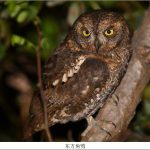
As ambiguous as the title of this piece sounds, a foray into the ornithological literature may lead to even more confusion. The family Furnariidae consists of ovenbirds and woodcreepers, but the actual Ovenbird belongs to the family of New World Warblers – Parulidae. This is not the most confusing aspect of birds by any means, after all there are tanagers which belong in the cardinal family and cardinals that are tanagers.
That out of the way, let’s talk about the members of this mega-diverse Neotropical family, the furnariids. These birds occupy literally every terrestrial habitat within their extensive range, from high altitude forests to coastal, rocky habitat. Their diversity extends to their diet as well, although the vast majority of furnariids feeds on arthropods their means of food acquisition varies tremendously. Some may sally like flycatchers, others probe under vegetation or even within flakes of bark.
Perhaps even more diverse is their nesting habits. Furnariids have the most diverse nests in any family of birds. Some species opt for the traditional oven-shaped nest (hence the family name), others use tunnels in embankments, some species build advanced and complicated structures to deter brood parasites. For all the diversity within the family, there is one characteristic which binds them all together – colour. Most, if not all furnariids are some shade of brown.
This similarity in colour (generally the first characteristic examined by birders) has led to some difficulty in the field, especially in areas where a plethora of brown birds flits about in difficult viewing conditions. Here in Trinidad & Tobago we live up to our reputation of being a comfortable introduction to the world of Neotropical birding – we only have ten (out of a staggering three hundred) furnariids. Five of these are woodcreepers, and I spoke about them a few weeks ago. Three of the remaining five are spinetails, cleverly distributed in three separate habitats.

All three spinetails vocalize repeatedly. In Trinidad’s scrub habitat, the Pale-breasted Spinetail gives a consistent two note churring call – hearing this is no indication of an impending sighting however, as they love to remain hidden.

The Yellow-chinned Spinetail is a nostalgic bird for me, as one of the first areas I began seriously birding in was a wetland – and you simply cannot visit a wetland in Trinidad and not hear a Yellow-chinned Spinetail.

The third spinetail is a complete forest denizen and spends its time hopping through leaf litter, searching for arthropods. Many hikers on both Trinidad and Tobago are familiar with the call of the Stripe-breasted Spinetail, as it sounds very much like an encouraging “keep going”.

Perhaps the true leaf litter specialist is the rarely seen Grey-throated Leaftosser. With a distinctive pot-bellied silhouette, it is rarely misidentified.

The final furnariid is the Streaked Xenops, probably much more common than we realize as it is so easy to miss as it forages along thin twigs in the middle and high storey.
Life is simple with ten furnariids – neighboring Guyana has 44!











Cool post about an interesting family of birds!